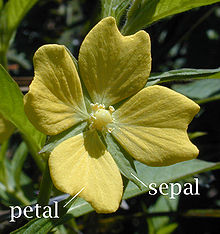Sepal

Diagram showing the parts of a mature flower. In this example the perianth is separated into a calyx (sepals) and corolla (petals)

Tetramerous flower of Ludwigia octovalvis showing petals and sepals.

After blooming, the sepals of Hibiscus sabdariffa expand into an edible accessory fruit

In many Fabaceae flowers, a calyx tube surrounds the petals.
A sepal (/ˈsɛpəl/ or /ˈsiːpəl/)[1][2][3] is a part of the flower of angiosperms (flowering plants). Usually green, sepals typically function as protection for the flower in bud, and often as support for the petals when in bloom.[4] The term sepalum was coined by Noël Martin Joseph de Necker in 1790, and derived from the Greek σκεπη (skepi), a covering.[5][6]
Collectively the sepals are called the calyx (plural calyces),[7] the outermost whorl of parts that form a flower. The word calyx was adopted from the Latin calyx,[8] not to be confused with calix, a cup or goblet.[9]Calyx derived from the Greek κάλυξ (kalyx), a bud, a calyx, a husk or wrapping, (cf Sanskrit kalika, a bud)[10] while calix derived from the Greek κυλιξ (kylix), a cup or goblet, and the words have been used interchangeably in botanical Latin.[11]
After flowering, most plants have no more use for the calyx which withers or becomes vestigial. Some plants retain a thorny calyx, either dried or live, as protection for the fruit or seeds. Examples include species of Acaena, some of the Solanaceae (for example the Tomatillo, Physalis philadelphica), and the water caltrop, Trapa natans. In some species the calyx not only persists after flowering, but instead of withering, begins to grow until it forms a bladder-like enclosure around the fruit. This is an effective protection against some kinds of birds and insects, for example in Hibiscus trionum and the Cape gooseberry.
Morphologically, both sepals and petals are modified leaves. The calyx (the sepals) and the corolla (the petals) are the outer sterile whorls of the flower, which together form what is known as the perianth.[12]
The term tepal is usually applied when the parts of the perianth are difficult to distinguish,[13] e.g. the petals and sepals share the same color, or the petals are absent and the sepals are colorful. When the undifferentiated tepals resemble petals, they are referred to as "petaloid", as in petaloid monocots, orders of monocots with brightly coloured tepals. Since they include Liliales, an alternative name is lilioid monocots. Examples of plants in which the term tepal is appropriate include genera such as Aloe and Tulipa. In contrast, genera such as Rosa and Phaseolus have well-distinguished sepals and petals.[citation needed]
The number of sepals in a flower is its merosity. Flower merosity is indicative of a plant's classification. The merosity of a eudicot flower is typically four or five. The merosity of a monocot or palaeodicot flower is three, or a multiple of three.
The development and form of the sepals vary considerably among flowering plants.[14] They may be free (polysepalous) or fused together (gamosepalous).[15] Often, the sepals are much reduced, appearing somewhat awn-like, or as scales, teeth, or ridges. Most often such structures protrude until the fruit is mature and falls off.
Examples of flowers with much reduced perianths are found among the grasses.
In some flowers, the sepals are fused towards the base, forming a calyx tube (as in the Lythraceae family,[16] and Fabaceae). In other flowers (e.g., Rosaceae, Myrtaceae) a hypanthium includes the bases of sepals, petals, and the attachment points of the stamens.
See also
| Wikimedia Commons has media related to Sepals. |
- Plant morphology
References
^ From French sépale, from New Latin sepalum, blend of sep- from Greek skepē, "a covering" and -alum from New Latin petalum, "petal", influenced by French pétale "petal".
^ "Oxford dictionary"..mw-parser-output cite.citation{font-style:inherit}.mw-parser-output q{quotes:"""""""'""'"}.mw-parser-output code.cs1-code{color:inherit;background:inherit;border:inherit;padding:inherit}.mw-parser-output .cs1-lock-free a{background:url("//upload.wikimedia.org/wikipedia/commons/thumb/6/65/Lock-green.svg/9px-Lock-green.svg.png")no-repeat;background-position:right .1em center}.mw-parser-output .cs1-lock-limited a,.mw-parser-output .cs1-lock-registration a{background:url("//upload.wikimedia.org/wikipedia/commons/thumb/d/d6/Lock-gray-alt-2.svg/9px-Lock-gray-alt-2.svg.png")no-repeat;background-position:right .1em center}.mw-parser-output .cs1-lock-subscription a{background:url("//upload.wikimedia.org/wikipedia/commons/thumb/a/aa/Lock-red-alt-2.svg/9px-Lock-red-alt-2.svg.png")no-repeat;background-position:right .1em center}.mw-parser-output .cs1-subscription,.mw-parser-output .cs1-registration{color:#555}.mw-parser-output .cs1-subscription span,.mw-parser-output .cs1-registration span{border-bottom:1px dotted;cursor:help}.mw-parser-output .cs1-hidden-error{display:none;font-size:100%}.mw-parser-output .cs1-visible-error{font-size:100%}.mw-parser-output .cs1-subscription,.mw-parser-output .cs1-registration,.mw-parser-output .cs1-format{font-size:95%}.mw-parser-output .cs1-kern-left,.mw-parser-output .cs1-kern-wl-left{padding-left:0.2em}.mw-parser-output .cs1-kern-right,.mw-parser-output .cs1-kern-wl-right{padding-right:0.2em}
^ "Collins dictionary".
^ Beentje, Henk (2010). The Kew Plant Glossary. Richmond, Surrey: Royal Botanic Gardens, Kew. ISBN 978-1-84246-422-9, p. 106
^ Stearn, William T. (2000). Botanical Latin, 4th ed.: 38-39.
ISBN 0-88192-321-4
^ Necker, N.J. de (1790). Corollarium ad Philosophiam botanicam Linnaei 18, 31
^ Shorter Oxford English dictionary, 6th ed. United Kingdom: Oxford University Press. 2007. p. 3804. ISBN 0199206872.
^ Jackson, Benjamin, Daydon; A Glossary of Botanic Terms with their Derivation and Accent; Published by Gerald Duckworth & Co. London, 4th ed 1928
^ John Entick, William Crakelt, Tyronis thesaurus, or, Entick's new Latin English dictionary. Publisher: E.J. Coale, 1822
^ Tucker, T. G. (1931). A Concise Etymological Dictionary of Latin. Halle (Saale): Max Niemeyer Verlag.
^ Stearn, William T. (2000). Botanical Latin, 4th ed.: 38
^ Davis, P.H.; Cullen, J. (1979). The identification of flowering plant families, including a key to those native and cultivated in north temperate regions. Cambridge: Cambridge University Press. p. 106. ISBN 0-521-29359-6.
^ Beentje 2010, p. 119
^ Sattler, R. 1973. Organogenesis of Flowers. A Photographic Text-Atlas. University of Toronto Press.
ISBN 0-8020-1864-5.
^ Beentje 2010, pp. 51 & 91.
^ Carr, Gerald. "Lythraceae". University of Hawaii. Archived from the original on 2008-12-05. Retrieved 2008-12-20.